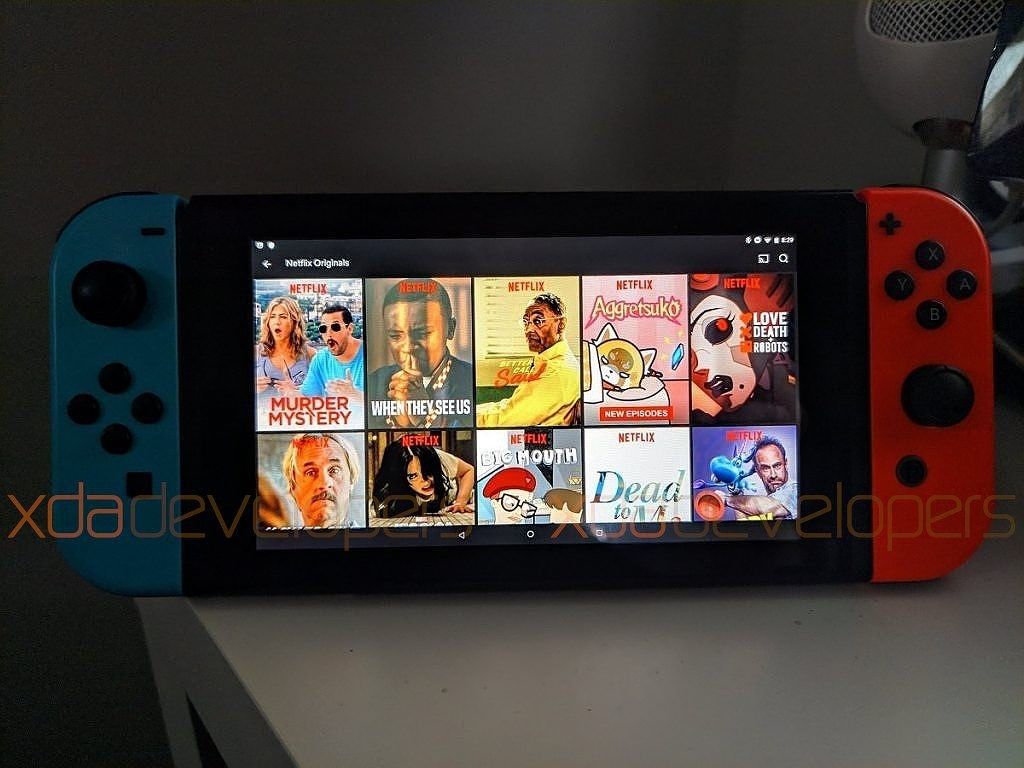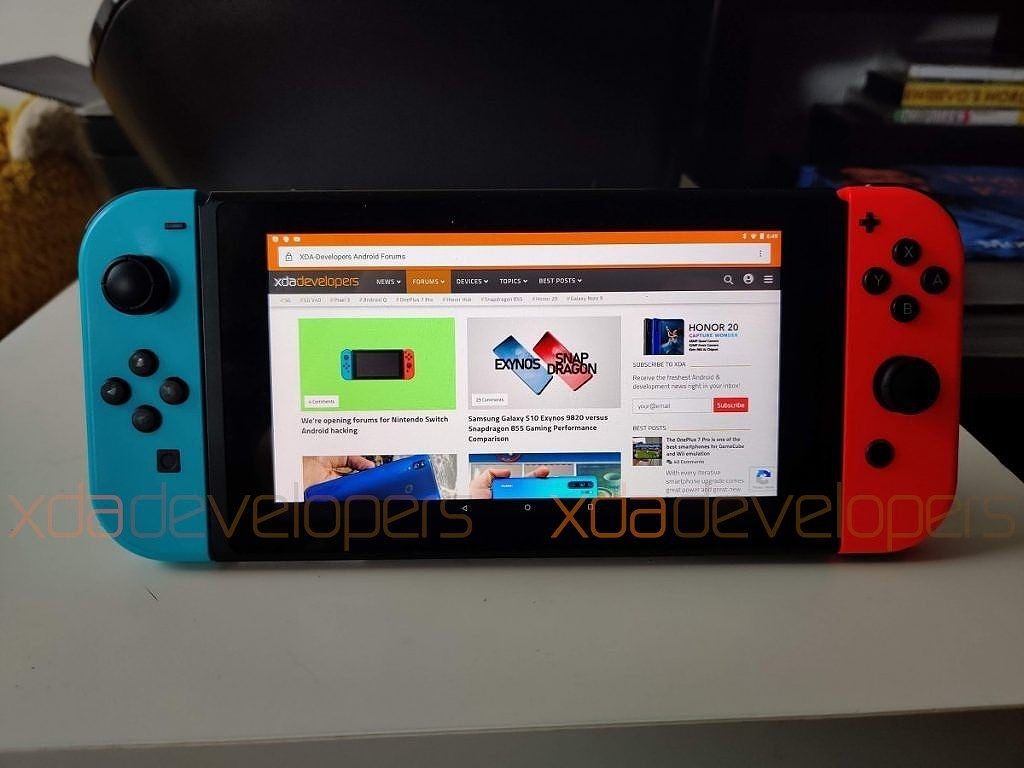
If you’ve kept up with the Nintendo Switch’s development scene as of late, you’ll have noticed that there’s a lot of cool things happening right now. Between the launch of L4T (Linux 4 Tegra) Ubuntu by ByLaws and the release of emuMMC for the Switch, there has never been a better time to own a (hackable) Nintendo Switch. Now, ByLaws has one-upped himself, as you can soon turn your Nintendo Switch into a full-fledged Android tablet – complete with dock and Joycon support. Before the public release, we got the opportunity to test Android on the Nintendo Switch to see what it can do.
How Android on the Nintendo Switch works
The Nintendo Switch was never meant to run Android. It’s a portable game console with a 6.2-inch 720p display powered by the Tegra X1 chipset (which is also found in the NVIDIA SHIELD Android TV), 4GB of LPDDR4 RAM, and a 4,310 mAh battery. It runs games like The Legend of Zelda: Breath of the Wild, Super Mario Odyssey, and Mario Kart 8: Deluxe. Those specifications make for a pretty beefy handheld games console, but imagine an Android tablet with those specifications? That’s effectively what we’ve got here thanks to ByLaws and fellow developers, and while it’s certainly not perfect yet, it’s already pretty powerful.
One of the most appealing aspects of the Switch is the fact that it is a hybrid console. When you put it in the Switch dock and detach the controllers on the sides, it becomes a full-fledged console with 1080p output via HDMI and higher CPU and GPU clock rates. When you’re done, just re-attach the controllers, take the Switch out of the dock, and use it wherever. A similar idea was employed by the NVIDIA SHIELD Tablet, an Android gaming tablet that could output to a TV at up to 8K resolution. Android on the Switch works in the same way as it once did on the NVIDIA SHIELD Tablet. Dock your Switch and it will output the display via HDMI, where you can continue to use it as normal on a bigger screen. The Switch dock also has 3 USB ports which you can plug a keyboard, mouse, and another peripheral into. At the moment, USB mass storage mounting does not work.
Other than that, Android on the Nintendo Switch works just like a tablet.

Android for the Nintendo Switch is currently based on the LineageOS 15.1 (Android 8.1 Oreo) build for the 2015 NVIDIA SHIELD Android TV (foster).
Media consumption
Typically, the number one reason anyone gets an Android tablet is for media consumption. A bigger, nicer screen is great for watching videos and playing games, which is where the Switch comes in. It has full support for all the apps on the Google Play store, so you can watch Netflix, YouTube, listen to music…pretty much all of the usual things you’d expect from an Android tablet. There are a few kinks to be ironed out of course, but none too serious. Think of this as the first build of LineageOS for an Android smartphone: It’s nowhere near complete or polished yet.

Netflix on the Nintendo Switch running Android. You can’t watch Netflix videos in HD as the Switch is not Widevine L1 certified. I tested viewing Breaking Bad and Love, Death & Robots.
If you’re a media fanatic and like to have files stored offline, then I have good news for you. Android for the Nintendo Switch can have as much storage as the SD card you put it on. That’s because part of the setup involves extending the /data partition to be the size that you want before booting, so I expanded it to fill the rest of my 64GB micro SD card. That means you’re not restricted to the 32GB eMMC storage onboard the Switch, and even more importantly, you aren’t modifying anything on the device itself.
Gaming Performance
As you may expect from the Tegra X1, gaming is a breeze. There are a few hiccups here and there, though I expect those are caused by the lack of optimization at this point in time. I tested PUBG Mobile, for example, and while the Joycons didn’t work, the game ran well on balanced graphics. I used balanced as the game would not let me go any higher, telling me that those options will come to my device “soon.”
The Joycons are another thing though, as they don’t currently work quite as seamlessly as you would expect yet. They need to be connected via Bluetooth, and leaving them physically connected to your Switch on the sides will still use them in wireless mode. There are no weird input delay issues like we had on the OnePlus 7 Pro. Technically, you can navigate the whole system UI with them. Not everything supports the Joycons yet, though. I had issues in Dolphin Emulator and Steam Link when trying them out, though it would appear that they worked perfectly in a previous build. As a result, I’m confident that they will be working again on release.
There was one emulator that I got working perfectly: DraStic. DraStic is one of the best Nintendo DS emulators on the Google Play Store, and it runs flawlessly on the Switch. That’s a massive achievement as there are no other DS emulators that work perfectly on it yet. I was able to play Pokemon Black with just my detached Joycons and my docked Switch via DraStic, which made for an enjoyable experience.
For emulating other game consoles, I recommend using RetroArch. I played Pokemon Leaf Green through it, and it worked with a single paired Joycon, though I had issues when I paired the second one as well. Other than that, it worked well and ran perfectly. You don’t need the functionality of two Joycons to play Pokemon either. SNES emulation is fantastic, and I played some of A Link to the Past through Snes9x.
At the moment, there are performance janks across the system that I can only imagine will be ironed out with time. The Tegra X1 on the Switch is underclocked compared to the SHIELD TV, but the Switch 8.0 update enabled game developers to boost the clock speed during loading screens, something which the Android build will also take advantage of on release (clock control has been added in the latest private build). The Nintendo Switch is already shaping up to be an excellent Android-powered gaming device, and the future for it in that regard is bright. I’m told as well that pretty much everything is functional, as it’s all been ported over from the NVIDIA SHIELD Android TV. There should be full support for the SoC and all of its capabilities.
What doesn’t work
Sadly, there are a number of drawbacks to using the Nintendo Switch as an Android tablet. For instance, the Switch doesn’t support GPS nor does it have a microphone or even a camera. That means no Pokemon Go, no voice and video calls with Google Duo, and no apps like Snapchat either. You can use a Bluetooth headset for audio, though it uses basic A2DP to connect. There is no LDAC or any other more advanced Bluetooth codecs in use here. The Joycons are also not compatible with every application yet, and it appears to be wildly inconsistent as to what they work with and what they don’t. RetroArch identified all four buttons on the left Joycon D-Pad to have the same functionality when they obviously don’t. You also can’t use the L and R buttons on the rail of each Joycon, which could be problematic when only using one. You also can’t take screenshots yet.
You asked, we tested
We posted on the XDA-Developers Twitter account asking our readers what they wanted to be tested on Android on the Nintendo Switch. We had a number of requests to test different games and applications, which you can read about above. We were also asked about Spotify (it works) and Fortnite (it doesn’t).
Flappy Bird was requested too. I tested it. It works. YouTube, Spotify, and Twitch all also work.
When does it release?
ByLaws and others involved in the Nintendo Switch’s development are working to get it ready for release. There’ll be an easy installer to use to set up your SD card, which at the moment is booted via Hekate. There is no expected ETA, though you should check out our Nintendo Switch forums and keep an eye on the thread for Android on the Switch!
The post We’ve got Android on the Nintendo Switch: Here’s what it can do appeared first on xda-developers.








0 comments:
Post a Comment